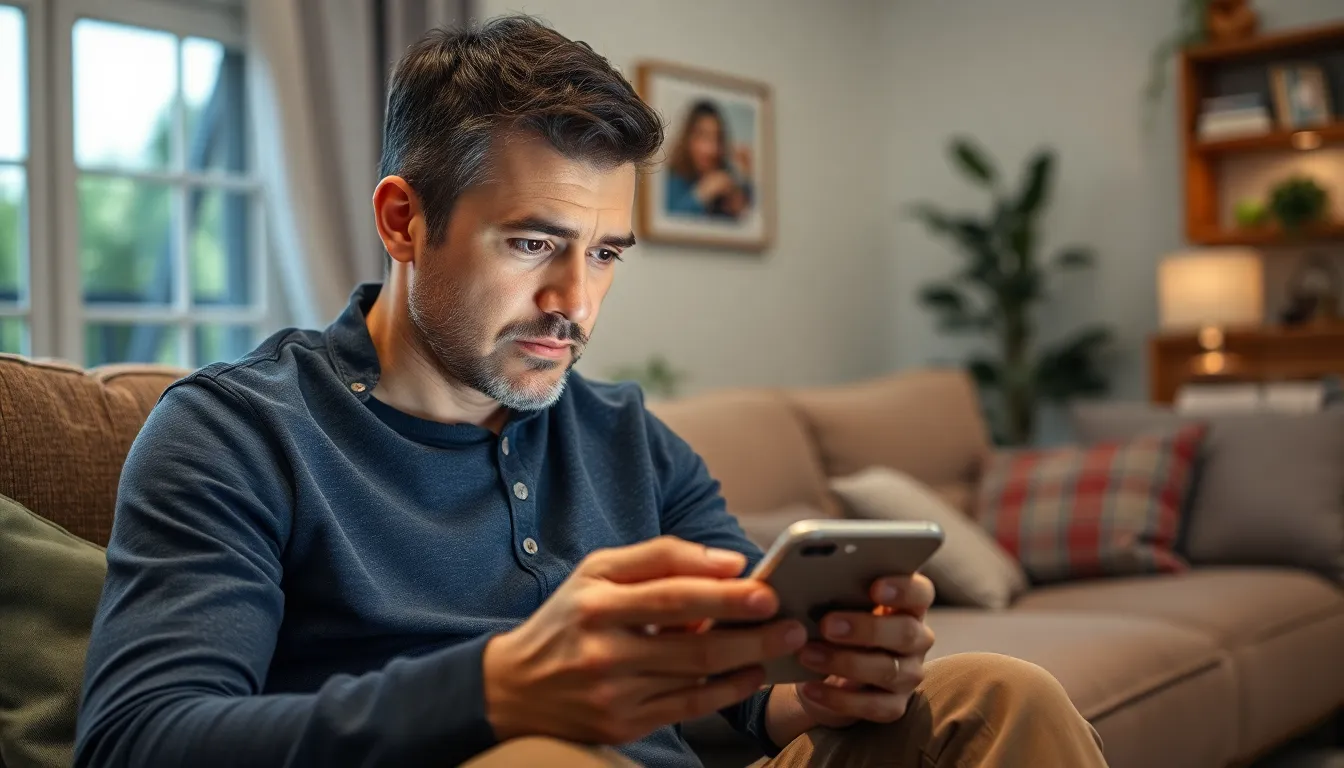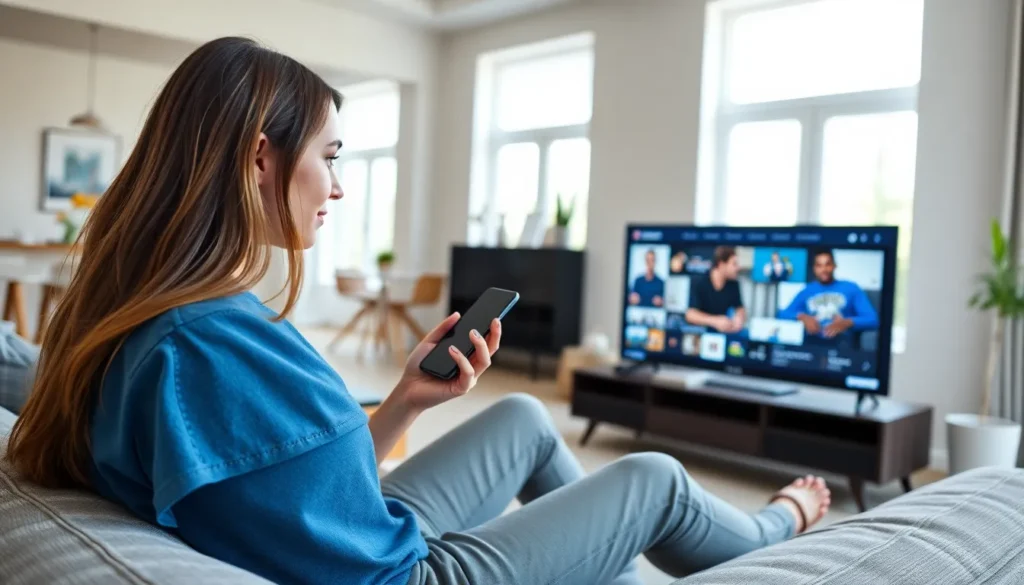Table of Contents
ToggleIn a world where sharing is caring, the idea of mirroring someone’s iPhone can sound like a tech-savvy dream come true. Imagine effortlessly accessing all those secret memes and playlists without lifting a finger—it’s like having a backstage pass to their digital life. But before you start plotting your tech takeover, let’s dive into the nitty-gritty of whether this is even possible.
While the thought of becoming a digital Sherlock Holmes might be tempting, it’s essential to tread carefully. Mirroring someone’s iPhone isn’t just about curiosity; it’s a blend of technology and ethics. So, can you really pull off this digital magic trick? Buckle up as we explore the ins and outs of iPhone mirroring, and find out if it’s a fun gadget to have or just a one-way ticket to trouble.
Understanding iPhone Mirroring
iPhone mirroring allows one device to display the screen of another device, enabling users to view content seamlessly. This feature provides a way to share information but raises ethical considerations in its usage.
What Is iPhone Mirroring?
iPhone mirroring refers to the process of duplicating an iPhone’s screen onto another display. Users can connect an iPhone to devices like Apple TV or smart TVs via AirPlay, creating a hassle-free viewing experience. Various apps also facilitate screen mirroring for non-Apple devices. Mirroring provides easy access to photos, videos, and presentations, making it useful for sharing content in personal or professional settings.
How Does It Work?
iPhone mirroring utilizes wireless protocols like AirPlay to transmit data. Users activate screen mirroring through their device’s Control Center, selecting the display they want to mirror. A stable Wi-Fi connection is crucial for effective mirroring, ensuring smooth performance without interruptions. Once connected, the mirrored content displays in real-time, allowing viewers to see exactly what appears on the iPhone screen. Compatibility with different devices extends mirroring capabilities beyond Apple products.
Reasons for Mirroring Someone’s iPhone

Multiple motives exist for mirroring someone’s iPhone, particularly in parenting and professional environments.
Parental Control
Parents often mirror their child’s iPhone to ensure safety and monitor usage. This practice allows them to oversee apps, messages, and browsing activities. By accessing content directly, parents can address inappropriate material and establish open conversations about online behavior. Using iPhone mirroring helps facilitate discussions about digital safety, promoting responsible internet use. Parents who employ this method support healthy technology habits while keeping their children accountable.
Employee Monitoring
Businesses frequently utilize iPhone mirroring for employee monitoring. Supervisors can observe device usage to maintain productivity and data security. Mirroring access enables employers to verify appropriate usage of company-issued devices. This practice ensures compliance with company policies and discourages misuse. Businesses that implement mirroring can better protect sensitive information while fostering a transparent workplace culture.
Methods to Mirror Someone’s iPhone
Mirroring someone’s iPhone can be achieved through various methods, each with unique features and considerations. The following explores these approaches in detail.
Using Third-Party Apps
Several third-party apps facilitate iPhone mirroring. Apps like Reflector, AirServer, and ApowerMirror enable users to clone an iPhone’s screen on another device. These options often include features for recording screens or streaming content, enhancing usability for diverse scenarios. Installation usually requires downloading the app on both devices and following prompts to establish a connection. Each application may have specific permissions needed for effective mirroring, which should be noted before attempting to use them.
Using Built-In Features
Built-in features provide another method for mirroring an iPhone. AirPlay stands out as the primary method to display content on devices like Apple TV or compatible smart TVs. Users enable AirPlay by swiping down on the iPhone screen to access the Control Center, tapping on Screen Mirroring, and selecting the target device. Successful connections depend on having both devices on the same Wi-Fi network, ensuring a reliable experience. This feature supports high-quality audio and video streaming, making it ideal for presentations or entertainment purposes.
Risks and Ethical Considerations
Understanding the risks of mirroring someone’s iPhone extends beyond technical skills. Ethical considerations and potential legal implications arise with these actions.
Legal Implications
Mirroring someone’s iPhone can breach privacy laws. Consent is crucial, as unauthorized access might violate state or federal regulations, depending on the jurisdiction. Many laws classify unauthorized monitoring of electronic communications as illegal. Penalties for such violations can range from civil fines to criminal charges. Familiarizing oneself with local laws helps avoid unintended legal consequences.
Trust and Privacy Issues
Trust issues emerge when one mirrors another’s device without consent. Relationships, whether personal or professional, can suffer significant harm due to breaches of privacy. Monitoring someone’s phone may create an environment of distrust and resentment. Respecting a person’s digital boundaries fosters healthy interactions. Open communication about intentions can alleviate misunderstandings and reinforce trust.
Mirroring someone’s iPhone can offer unique advantages in various settings but comes with significant ethical and legal considerations. It’s crucial to weigh the benefits against the potential risks involved. Respecting privacy and obtaining consent should always be a priority to avoid damaging relationships or facing legal repercussions.
Understanding the tools and methods available for iPhone mirroring empowers users to make informed decisions. Whether for parental oversight or workplace productivity, responsible use can lead to positive outcomes. Ultimately, fostering trust and communication is essential in navigating the complexities of digital interactions.




